 Mosaics are a very interesting form of decorative art. By themselves each piece of material isn’t much to look at, but place them in a pattern and they make some astounding works of art. In my twisted gaming mind, I think of board games that use the tile laying mechanic in the same way. They start with just a simple starting tile and by the end of the game, the board can look amazing.
Mosaics are a very interesting form of decorative art. By themselves each piece of material isn’t much to look at, but place them in a pattern and they make some astounding works of art. In my twisted gaming mind, I think of board games that use the tile laying mechanic in the same way. They start with just a simple starting tile and by the end of the game, the board can look amazing.
Carcassonne is a game that fits this description for me. In Carcassonne, players take on the role of founders that are putting together a southern French landscape. Through the placement of their followers, players claim different completed features to gain points for victory. Just because a game board fits together so well doesn’t necessarily mean it’s a good game. Carcassonne is a Spiel Der Jahres winner back in 2001 and can be played with any combination of 2-5 players.
Game Overview:
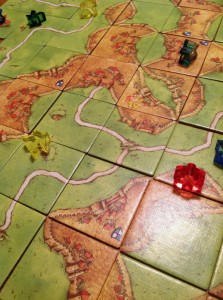
The game of Carcassonne is based on an actual southern French city. The city is known for its heavily fortified walls and this, plus other features of the countryside, are what inspired the game. Players take the roles of founders of the area and each of them wants to make their own stamp on the terrain. On each players turn, they will place a new tile onto the table. These tiles have a combination of city, road, field and monastery segments on them and players connect them to other pieces already on the board. Players also have a collection of followers at their disposal that they can use to claim areas on the tile they just placed. When these followers (or meeples as they are called) are placed on the board, they become thieves, knights, monks and farmers that help the player with the development of the land around Carcassonne. Players gain points through these meeples and the player with the most points after the last tile is played is the winner.
Game Components:
The components of Carcassonne are sparse. The game comes with over 70 land tiles that are surprisingly detailed. It’s obvious that they took a lot to time to make sure that this essential component for the game looked good and was high quality. One other nice feature is that the backside of the start tile is a different color scheme then the other tiles. Makes it super easy to find that starting piece at the beginning of the game.
The rule book is very detailed with pictures to deal with clarifications and major issues that come up in the game. The only other two items that come with the game is a scoreboard, nothing exciting there, and the follower pieces. These are very simple pieces and have become one of the most recognizable game pieces in the modern board gamer era: meeples. One negative about the components of the game is the same issue as in Settlers of Catan, the fluidity of the game board. Players will inadvertently hit a tile and cause everything to shift. If you have OCD, it might cause you to lose your mind. It isn’t as bad, but can be annoying.
How to Play:
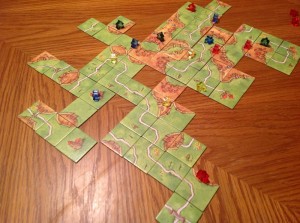
The game play of Carcassonne is very simple. The game starts with a starting tile and then the rest of the tiles are mixed and placed face-down on the table. Each player takes his eight selected colors meeples and the game can begin. Players gets three actions and then the play goes on to the next player.
1. Place a tile
2. Deploy a follower (optional)
3. Score completed roads, cities or cloisters
1. Place a tile
Players will draw a tile from a pile and each tile will have one of 3 features on the edges. There will be either green farmland, a rustic road, or a medieval city. Players must make the decision on where to place this piece on the board. Players can not just randomly place the tile anywhere. They must attach to any previously played tile and must match all sides to place the tile. The other feature will be a cloister/monastery that is located in the middle of the tile. Each one of these landscapes can build on to places the player has followers on or gives options for players to put their followers in the next step.
2. Deploy a follower
During this phase, a player may place one of their meeples from their supply on to any of the 4 possible land types on the tile they just played. If they take one of these spots in the farmland, road, city, or cloister the meeple now takes the role of a farmer, thief, knight or monk respectively. These followers will remain on that tile until the road, city or cloister is completed. The farmer will stay on the board until the end of the game. The one catch with playing a follower is that no other player’s meeples can be on the same connected land type, even yours. For instance, if you attach a piece that connects to a city segment, you can’t place a follower in the city if another knight is already in that city. Part of the strategy of tile placement is to place tiles that allow you to later connect with larger roads, cities and farmland. By doing this, a player can gain the same points as the other player if there is a tie or leave them in the dust and take all the points for yourself if you have the majority.
3. Score completed roads, cities or cloisters
All the land types listed above can be completed before the game ends. Players receive a point for each tile that is used to complete the road. The city tiles form a completed city when the segments are fully surrounded by a city wall. For each player that has the majority of followers in that city they gain two points per tile. Once all areas around the cloister tile are filled, the player receives nine points. Players can gain points on other players turns if that player completes any of the features above. Every time you or another player complete one of these segments, you gain the follower back into your reserves. It’s a balancing act to keep enough followers in your supply and try to put as many tiles as possible on each segment to gain the most points.
When the last tile has been played, all uncompleted segments of road, city and cloisters are counted. Farms values are determined at the end of the game. Farms are separated by cities and roads on the game board. This is one of the more confusing parts of the game. It takes a decent amount of explaining to make sure people understand how these are scored. Once the owner of each farm is established they gain 3 points for every completed city that borders the farm.
After all the points are counted, the player with the most victory points is the winner.
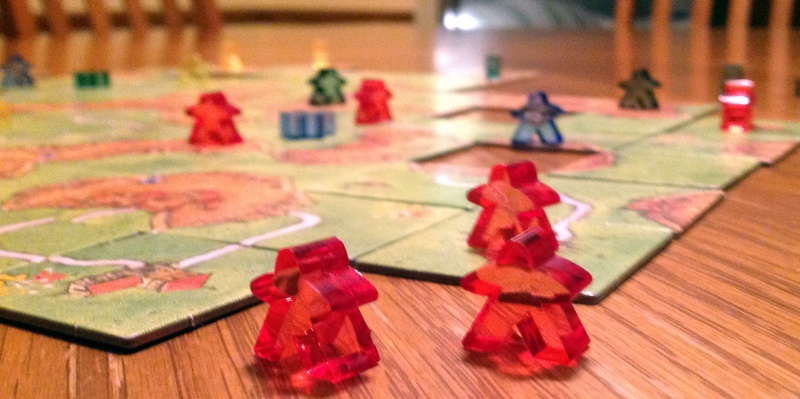
Game Experience:
As we said in our review of Settlers of Catan, any game that has won the Spiel Der Jahres is a game that is easy to learn and has solid game play. Carcassonne doesn’t buck this trend. For ease of play, it’s top notch. Whenever I play a new game, I think of the ease of play and how quickly it would take a non-gamer to figure out how to play and enjoy. Carcassonne doesn’t involve any complicated charts or paralyzing game play. The decisions in this game are so basic that will only take one explanation to get people who have never seen the game before to feel comfortable with it. It’s a very straightforward tile laying game that is a great game to introduce to people new to gaming (gateway game).
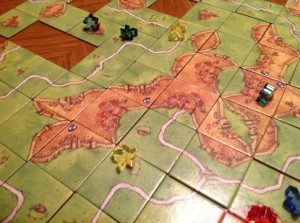
However, some of you don’t care about ease of play and want to know the nitty gritty about the game. Calm down, here it comes. The game isn’t a very deep game. As described above, there isn’t a ton of strategy elements to your turn. Because of this, Carcassonne can’t be considered a very “meaty” game. However, that doesn’t mean there isn’t mechanics in this game that allow for difficult decisions to make on your turn. Players need to decide if they should finish that city and gain the points or do you place it next to another city to attempt to steal some points from another player. All while trying to keep enough followers so when a cloister or something else comes up, you can pounce on that opportunity. After players get about half of their followers out there, it become much more difficult to just throw your followers around without any thought. There is also a lot of randomness in the game because all of the tile pieces are different and there is no guarantee that you will get the piece that fits into the spot you want. This can cause some of your best laid plans to go to waste. If you happen to play with a very serious player that hates randomness, they will get annoyed. But for me, this when a lot of the fun starts.
There is a great amount of tension that is formed when you are searching for a piece. Every time that person draws a tile, everyone turns to look to see their reaction. Every tile placed affects everyone else and no one is playing on their own game on the side. Players have to watch what each person is doing to try to block them or help yourself to their spoils. I have seen tiles thrown and colorful words uttered when another player’s move hurts others plans. This is where the game thrives and makes it a classic game to own.
One other thing I enjoy about Carcassonne is watching the board grow as the game progresses. Since there is no set placement besides just adjacent to another tile, the game board will form organically and varied every time. I have seen cities that use over 18 tiles and roads that go off into the distance with nothing else around them. Players get the sense as they are building something as they play. By the end of the game, players feel pride at the landscape they have created and laugh at the silly outcomes. When the game is done, it’s a shame that you have to take it all apart and put it back in the box (although I have seen people frame their Carcassonne tiles into wall art).
Final Thoughts:
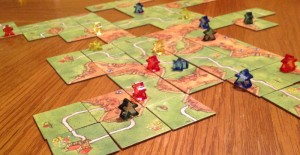
Carcassonne fits that opening game niche that every game groups need. Its very quick game play, ease of learning and high level of player interaction make the game a great start to your gaming session. The game won’t make your head explode with complexity, but isn’t a game that you can just put your brain on autopilot and expect to do well. Due to the immense popularity of the game during the first 5 years of release, the game has seen over seven expansions come to the market. These bring in new game elements and even more tiles, totaling over 300 if you bought them all. The game has endless replay value and the expansions will bring new ways to play the game that will keep it fresh and varied. With all these options, it’s no surprise I’m always willing to play Carcassonne over and over again. Even without adding any expansions, the base game is a great add to your gaming collection for your gamer and non-gamer friends to enjoy. Everyone should have a copy of this Spiel Der Jahres winner in their gaming library.
If you are interested in getting a copy for yourself, it’s about $25.
Final Score: 5 Stars – A quick tile placement gateway game that is a joy to play again and again.
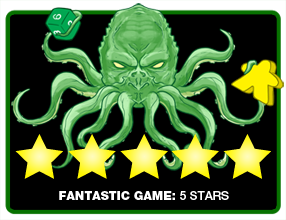 Hits:
Hits:
• Quick game play
• Easy to learn
• Finished game board looks awesome
Misses:
• Randomness could turn some away
• Could be too light for some







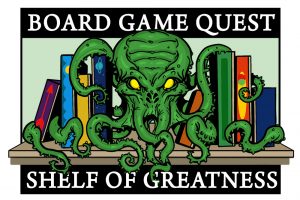














I have played this game a couple of times – my son really rates it.
I would summarize by saying that it is a good after dinner game and ideally played with four gamers.
I would point out that it plays a whole lot better with one of the extensions – I have the river extension pack (but there are others).
Tony
I agree. There are a whole pile of expansions for it. Some are much better than others too.
Great review!
I played this once on a whim with my wife. Initially we found the scoring a little confusing but once we muddled through and started to get a grasp of the game I enjoyed it.
It is a quick play (after dinner is a good way to state it) and that is always something I appreciate.
The two player game of Carcassonne is actually much deeper once you master it. Luck can be nearly completely mitigated by solid play. The depth of the game isn’t easily apparent, but I promise you that it exists in two player games.
Agree with Chuck. Two players make for a nice challenge. We altered the rules by allowing each player to draw two tiles so that one has a choice in the next play. Retain one and place the other.